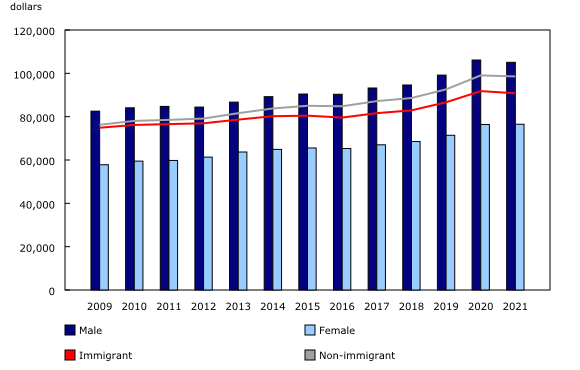Environmental and Clean Technology Products Economic Account: Human Resource Module, 2021
Released: 2023-10-16
In 2021, environmental and clean technology (ECT) activity generated 314,257 employee jobs in the Canadian economy, up about 6% from the previous year. The ECT sector represented almost 2% of all jobs in Canada in 2021. For the following analysis, the term "jobs" is used to refer to employee jobs.
Two broad categories of jobs are associated with the production and delivery of ECT products: those associated with environmental goods and services and those related to the provision of clean technology goods and services.
The environmental products subsector represented almost 4 out of 10 jobs (or 125,463 jobs) in the ECT sector in 2021. This subsector includes the production of clean electricity, biofuels and primary goods, as well as the delivery of waste management and remediation services.
The remaining jobs (60% of the sector, or 188,794 jobs in 2021) were found in the clean technology products subsector, which includes the production of manufactured goods (e.g., solar panels, efficient turbines, electric batteries), as well as the delivery of professional, scientific and technical services, construction services, and support services.
The environmental and clean technology workforce is predominantly male
In 2021, men held 71% of jobs in the ECT sector (224,328 jobs), while the 89,929 remaining jobs were held by women. These shares were similar in reference year 2020. The two ECT subsectors presented a different gender distribution: 75% of the environmental products subsector jobs were held by males in 2021, while they represented 69% in the clean technology products subsector.
The increase in jobs observed in the ECT sector from 2020 to 2021 affected the number of jobs held by men (+7%, from 209,508 to 224,328 jobs) slightly more than women (+5%, from 85,704 to 89,929 jobs).
As in 2020, the majority of the ECT sector's workforce was equally divided among the age ranges from 25 to 54 years (25 to 34, 35 to 44, and 45 to 54 years). In 2021, a higher proportion of people aged 55 and older had employment in the ECT sector (24%) as compared to the economy as a whole (22%).
Average annual compensation in the environmental and clean technology sector, including benefits, is higher than the national average
In 2021, average annual compensation in the ECT sector, including benefits, declined slightly to $96,910 compared with $97,504 a year earlier. The amount in 2021 was $27,387 higher than the Canadian economy average annual compensation of $69,523.
On average, women working in the ECT sector earned 73% ($76,503) of men's salaries ($105,091) in 2021, compared with 70% reported in 2009.
The leading occupation group linked to ECT activities for 2021 was in trades, transport and equipment operators and related occupations, except management (111,239 jobs).
Note to readers
The aim of the Human Resource Module (HRM) is to provide timely and reliable statistics on the human resources associated with environmental and clean technology activities production in Canada.
The HRM complements and enhances the analytical capacity provided by the Environmental and Clean Technology Products Economic Account and allows for a broader insight into the sector's role in the economy by providing more detailed human resource information (e.g., gender, age, education, immigration status, Indigenous identity, wages and occupation types).
Data for this module are now available on tables 36-10-0691-01, 36-10-0692-01, 36-10-0693-01, and 36-10-0694-01. A methodology adjustment and the use of the latest Census data lead to the revision of the whole time series. Today's dissemination then replaces the data released on April 26, 2022, available on request, which covered the period from 2009 to 2020.
Estimates for 2020 and 2021 are preliminary and will be revised when updated data become available, including the supply and use tables for those reference years.
The HRM provides annual estimates that cover employee jobs only. These estimates are based on national data from the Canadian Productivity Accounts, which are a key input to the HRM, as well as Labour Force Survey data. Data from the 2006, 2016 and 2021 Census of Population, as well as from the 2011 National Household Survey, are also incorporated.
Environmental and clean technologies are defined as any process, product or service that reduces environmental impacts through any of the following three strategies: environmental protection activities that prevent, reduce or eliminate pollution or any other degradation of the environment; resource management activities that result in the more efficient use of natural resources, thus safeguarding against their depletion; or the use of goods that have been adapted to be significantly less energy or resource intensive than the industry standard.
Contact information
For more information, or to enquire about the concepts, methods or data quality of this release, contact us (toll-free 1-800-263-1136; 514-283-8300; infostats@statcan.gc.ca) or Media Relations (statcan.mediahotline-ligneinfomedias.statcan@statcan.gc.ca).
- Date modified:

